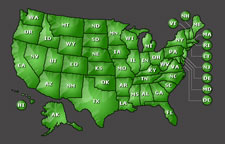
Bats in the House
Bats in the house is a fairly common problem that occurs mostly in the late spring and summer in many parts of the US. However it is not uncommon to hear of bats in the house year round. I will break this page of the website down by Seasons. This is necessary to try and explain what is happening and what some of the possibilities are for having a bat in your house at any time of the year. We will start with spring, this seems to be the time of the year that many wildlife removal companies gets lots of calls, particularly in the eastern Part of the US.
Spring
Bats in the house in the spring of the year is a fairly common complaint that many professional animal removal experts will receive. This is because it is at this time of year that bats become active, sometimes very active. Bats are just emerging from their winter nap and are on the constant lookout for food. This includes all different types of bugs such a Mosquitos, Moths and other flying insects. It is in their search for food that bats sometimes find themselves in close proximity to humans. People think that on their early evening walks that bats are dive bombing them, this is not the case, they are in fact after the bugs that are following you as you walk. During this time period bats will often feed many hours and you may start to notice scratching sounds in your ceiling or walls. This is the first clue that you may have bats in the house.
Summer
Summer is the time that bats will usually split into different colonies; you will have a paternal colony and a bachelor colony.
A paternal colony is usually large colony of female bats that have separated from the male bats in order to have young. They usually look for the warmest places in a structure since their babies are born”naked”. This is usually in an Attic area. The babies will need the heat from an outside source in order to survive. The time period between birth and 3 weeks old is a normal time, with only the adults flying in the late evening and very early morning hours of the day. When the baby bats start to get a little older, they become more active, they start to move around and scratch on the sheetrock and walls where they are living, the noise they make becomes more noticeable, you may also hear some auditable squeaking, this is the female bats trying to locate their young in the attic or wall of the home. You may also start to see bat bugs in your home.
As the baby bats get older, they start to crawl around in the attic or wall of the home or building, exploring cracks and crevices that sometimes turns out to be a vent or duct work pipe that comes down into your home. This is where we start to get more calls of people finding bats in the house. Baby bats ar e fully independent at 6 weeks of age, so this time period goes by pretty quickly.
Fall
Fall is a time when Maternal colonies will start to break up, The baby bats are no longer dependent on mother milk or the warmth of their birth place, they are now 100 % on their own. Studies have showed that after bats are weaned from their mother, the mother bat does not socialize with her young bat again.
It is in this time period that all the bats start to make their way towards their winter roosting sites. And start to very aggressively eat in order for them to store fat for the up and coming winter.
This is also the time period in which the male bat rejoins the colony and starts the mating process over again. Bat go thru a process called delayed fertilization in which the female bat will wait until she has a acceptable food source available before her body will trigger the process of egg fertilization. Thus assuring acceptable weather and plenty of food availability during pregnancy. This is a very active period for complaint calls about bats. This is also the time period in which most states will allow you to exclude these animals from your home. They have a protected status in all states. To find out how to get bats removal from your attic
Winter
Winter is the time when most bat complaints slow down, as most bats are starting their Torpor(long nap) As the winter gets colder their state of Torpor will get longer and longer, finally a bats body functions will start to self-regulate, their body temperature will drop, their breathing will become slower and they will have a lower metabolic rate. You may see bats active during long warm periods in the winter, however this is very seldom and most bats will be at rest until early spring. When the cycle starts over again. After many years of this cycle, you may devolpe
After many years of this cycle, you may devolpe a very large bat colony, as they tend to return to the same place to have babies year after year. The babies also return to have their babies and so on and so on! After many years of this you may have a bat guano cleanup issue that you need taken care of. This stuff is toxic and should be handled by a professional. For your convenience we have created a bat calendar so you can see what the bats are up to in your area of the country.
We have many pages on several different species of bats, please use our main bat removal page for specific species of bats needing controlled..

